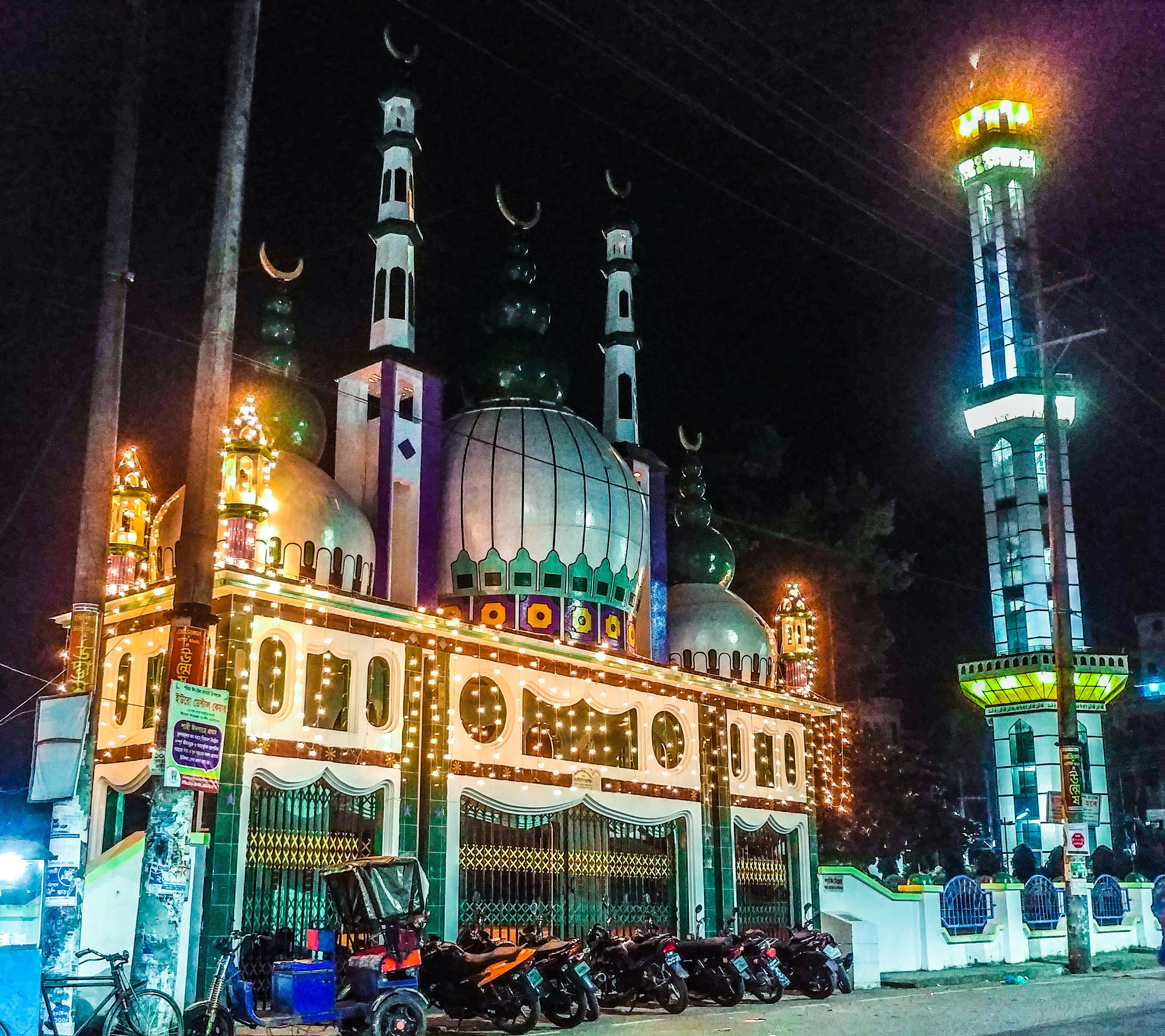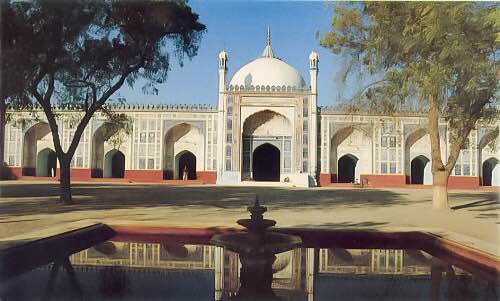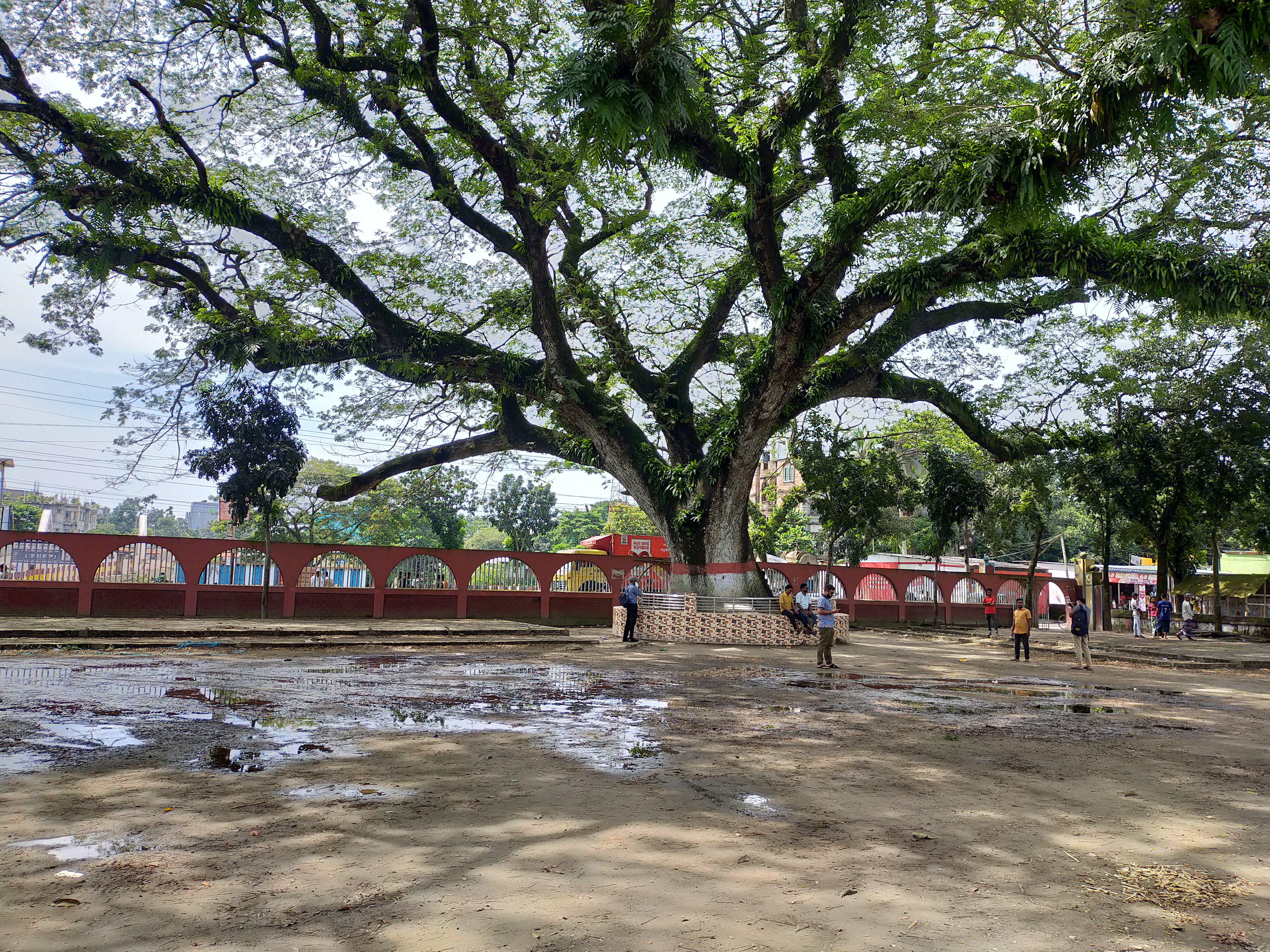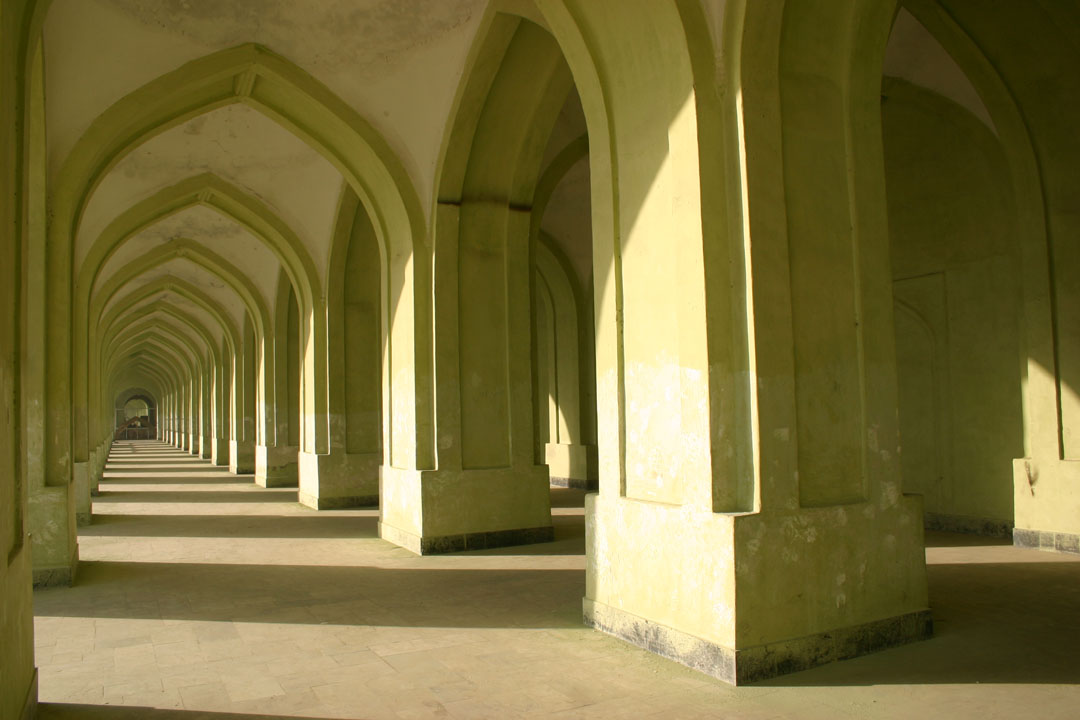|
Eidgah
Eidgah or Idgah, also Eid Gah or Id Gah ( fa, "site of Eid bservances; bn, ঈদগাহ; pnb, ; ur, ; hi, ईदगाह) is a term used in South Asian Islamic culture for the open-air enclosure usually outside the city (or at the outskirts) reserved for Eid prayers offered in the morning of Eid al-Fitr and Eid al-Adha. It is usually a public place that is not used for prayers at other times of the year. On the day of Eid, the first thing Muslims do in the morning is gather usually at a large open ground and offer special prayers, in accordance with the Sunnah (traditions of Muhammad). Although the usage of the term ''Eidgah'' is of Indian origin, it may be used for the ''musalla'', the open space outside a mosque, or other open grounds where Eid prayers are performed, due to the lack of a specific Islamic term for a site of Eid observance. The Eidgah is mentioned in the famous Bengali poem by Kazi Nazrul Islam, O Mon Romzaner Oi Rozar Sheshe. Prescriptions in the ... [...More Info...] [...Related Items...] OR: [Wikipedia] [Google] [Baidu] |
Sylhet Shahi Eidgah
Sylhet Shahi Eidgah ( bn, সিলেট শাহী ঈদগাহ), or simply Shahi Eidgah, is an open prayer hall situated in Sylhet, north-east Bangladesh, three kilometers to the north-east of the circuit house, meant for the Eid prayers. It was built during the rule of Mughal Sultan Sarfaraz Khan. More than 100,000 people can perform prayer at same time in this eidgah. It is also one of the most visited tourist spots in the city. Recently, the gates were rebuilt to ensure safety and security. As well as for prayer uses and Islamic congregations, the eidgah has historically been a place to give speeches and host rallies by the likes of Mohandas Gandhi and Muhammad Ali Jinnah. There have also been battles taken place there such as the Muharram Rebellion. History During the rule of Mughal emperor Aurangzeb, Farhad Khan was appointed as the faujdar of Sylhet. Farhad Khan supervised the construction of the Shahi Eidgah on a hill in the 17th century. On 16 December 1782 (10 Mu ... [...More Info...] [...Related Items...] OR: [Wikipedia] [Google] [Baidu] |
Eidgah Mosque
Eidgah or Idgah, also Eid Gah or Id Gah ( fa, "site of Eid bservances; bn, ঈদগাহ; pnb, ; ur, ; hi, ईदगाह) is a term used in South Asian Islamic culture for the open-air enclosure usually outside the city (or at the outskirts) reserved for Eid prayers offered in the morning of Eid al-Fitr and Eid al-Adha. It is usually a public place that is not used for prayers at other times of the year. On the day of Eid, the first thing Muslims do in the morning is gather usually at a large open ground and offer special prayers, in accordance with the Sunnah (traditions of Muhammad). Although the usage of the term ''Eidgah'' is of Indian origin, it may be used for the ''musalla'', the open space outside a mosque, or other open grounds where Eid prayers are performed, due to the lack of a specific Islamic term for a site of Eid observance. The Eidgah is mentioned in the famous Bengali poem by Kazi Nazrul Islam, O Mon Romzaner Oi Rozar Sheshe. Prescriptions in the ... [...More Info...] [...Related Items...] OR: [Wikipedia] [Google] [Baidu] |
Sholakia Eidgah Maidan
Sholakia ( bn, শোলাকিয়া) is a locality near Kishoreganj town in Bangladesh. It is famous for its Eidgah where the largest congregation of Eid prayer in Bangladesh is held on the occasion of '' Eid ul-Fitr'', the day of celebration after the Ramadan, the month of fasting. 400,000 people join the prayer on every Eid. The Eidgah, on the bank of river Narosunda is reported to be in size, accommodating 250 rows or about 150,000 of participants for every congregation. An equal number of participants take part in the prayer using the fields, roads and courtyards around the Eidgah. A small number of elites make use of the two-storied mimbar (prayer hall with towers for '' adhan'') nearby, which can accommodate about 500 people. The prayer on the occasion of '' Eid ul-Adha'', the festival of ''qurbani'' or sacrifice, is also comparably large. The regular population of Sholakia is 1,026, consisting 180 households. Organization Mufti Moulana Farid Uddin Masud has been ... [...More Info...] [...Related Items...] OR: [Wikipedia] [Google] [Baidu] |
Eid Al-Fitr
, nickname = Festival of Breaking the Fast, Lesser Eid, Sweet Eid, Sugar Feast , observedby = Muslims , type = Islamic , longtype = Islamic , significance = Commemoration to mark the end of fasting in Ramadan , date = 1 Shawwal , date2019 = 4 June (Saudi Arabia and some other countries) 5 June (Pakistan and some other countries) , date2023 = 21 – 22 April , date2024 = 10 – 11 April , celebrations = Eid prayers, charity, social gatherings, festive meals, gift-giving, dressing up, Lebaran , relatedto = Ramadan, Eid al-Adha Eid al-Fitr (; ar, عيد الفطر, Eid al-Fiṭr, Holiday of Breaking the Fast, ) is the earlier of the two official holidays celebrated within Islam (the other being Eid al-Adha). The religious holiday is celebrated by Muslims worldwide because it marks the end of the month-long dawn-to-sunset fasting of Ramadan. It falls on the first day of Shawwal in the Islamic calendar; this does ... [...More Info...] [...Related Items...] OR: [Wikipedia] [Google] [Baidu] |
Dhanmondi Shahi Eidgah
The Dhanmondi Shahi Eidgah ( bn, ধানমণ্ডী শাহী ঈদগাহ), also known as Mughal Eidgah ( bn, মোগল ঈদগাহ), is located in Saat Masjid road, in Dhanmondi residential area of Dhaka, Bangladesh. The Eidgah was built in 1640 CE during the Mughal era and has been in use for Eid celebration since then. The structure is a listed archaeological site of the Department of Archaeology and has historical, architectural and heritage values. It is an example of Mughal architecture. Conservationist architect Abu Sayeed M Ahmed wrote, "This Eidgah is the oldest surviving Mughal monument in Dhaka city. There is no second one with the architectural forms and features similar to it." History The Mughal Eidgah is a monumental structure built during the Mughal Empire. the Eidgah was built by Mir Abul Qasim, a Diwan of Shah Shuja and builder of Boro Katra. The Mughal subahdars and diwans living in this land used to come to the Eidgah for Eid prayers ... [...More Info...] [...Related Items...] OR: [Wikipedia] [Google] [Baidu] |
Mosque
A mosque (; from ar, مَسْجِد, masjid, ; literally "place of ritual prostration"), also called masjid, is a place of prayer for Muslims. Mosques are usually covered buildings, but can be any place where prayers ( sujud) are performed, including outdoor courtyards. The first mosques were simple places of prayer for Muslims, and may have been open spaces rather than buildings. In the first stage of Islamic architecture, 650-750 CE, early mosques comprised open and closed covered spaces enclosed by walls, often with minarets from which calls to prayer were issued. Mosque buildings typically contain an ornamental niche ('' mihrab'') set into the wall that indicates the direction of Mecca (''qiblah''), Wudu, ablution facilities. The pulpit (''minbar''), from which the Friday (jumu'ah) sermon (''khutba'') is delivered, was in earlier times characteristic of the central city mosque, but has since become common in smaller mosques. Mosques typically have Islam and gender se ... [...More Info...] [...Related Items...] OR: [Wikipedia] [Google] [Baidu] |
Fatwa
A fatwā ( ; ar, فتوى; plural ''fatāwā'' ) is a legal ruling on a point of Islamic law (''sharia'') given by a qualified '' Faqih'' (Islamic jurist) in response to a question posed by a private individual, judge or government. A jurist issuing fatwas is called a ''mufti'', and the act of issuing fatwas is called ''iftāʾ''. Fatwas have played an important role throughout Islamic history, taking on new forms in the modern era. Resembling ''jus respondendi'' in Roman law and rabbinic ''responsa'', privately issued fatwas historically served to inform Muslim populations about Islam, advise courts on difficult points of Islamic law, and elaborate substantive law. In later times, public and political fatwas were issued to take a stand on doctrinal controversies, legitimize government policies or articulate grievances of the population. During the era of European colonialism, fatwas played a part in mobilizing resistance to foreign domination. Muftis acted as independent s ... [...More Info...] [...Related Items...] OR: [Wikipedia] [Google] [Baidu] |
Eidgah, Kheri
Eidgah or Kheri Eidgah is a mosque and Eidgah near the railway tracks between Lakhimpur and Kheri. Construction The foundation of the historic Eidgah was laid in North West of Kheri Town, outside the dwelling area. Architecture The courtyard of the mosque can be reached from entrances on three sides. On the day of Eid, the area outside mosque is used for food stalls, shops and by street entertainers. See also *Eidgah *Islamic architecture Notes External links Flickr Flickr ( ; ) is an American image hosting and video hosting service, as well as an online community, founded in Canada and headquartered in the United States. It was created by Ludicorp in 2004 and was a popular way for amateur and professional ...: Photos tagged wit"Eidgah Kheri"{{Mosques in India Mosques in Uttar Pradesh Tourist attractions in Lakhimpur Kheri district Eidgahs ... [...More Info...] [...Related Items...] OR: [Wikipedia] [Google] [Baidu] |
Kashgar, Xinjiang
Kashgar ( ug, قەشقەر, Qeshqer) or Kashi ( zh, c=喀什) is an oasis city in the Tarim Basin region of Southern Xinjiang. It is one of the westernmost cities of China, near the border with Afghanistan, Kyrgyzstan, Tajikistan and Pakistan. With a population of over 500,000, Kashgar has served as a trading post and strategically important city on the Silk Road between China, the Middle East and Europe for over 2,000 years, making it one of the oldest continuously inhabited cities in the World. At the convergence point of widely varying cultures and empires, Kashgar has been under the rule of the Chinese, Turkic, Mongol and Tibetan empires. The city has also been the site of a number of battles between various groups of people on the steppes. Now administered as a county-level unit, Kashgar is the administrative center of Kashgar Prefecture, which has an area of and a population of approximately 4 million as of 2010. The city itself has a population of 506,640, and its urb ... [...More Info...] [...Related Items...] OR: [Wikipedia] [Google] [Baidu] |
Id Kah Mosque
The Id Kah Mosque ( ug, ھېيتگاھ مەسچىتى, translit=Hëytgah Meschiti, ; zh, s=艾提尕尔清真寺, t=艾提尕爾清真寺, p=Àitígǎěr Qīngzhēnsì; from Persian: عیدگاه, Eidgāh, meaning "Place of Festivities") is a historic mosque and tourist site located in Kashgar, Xinjiang, China. History The mosque was built by Saqsiz Mirza, the elder of two sons of Amir Sayyid Ali, in 1442 (although it incorporated older structures dating back to 996) to commemorate his ancestors. The mosque covers an area of around 16,000 square meters. The mosque's modern golden-brick structure was built in 1798, replacing the older building, and was further expanded in 1838 to its current size. On 9 August 1933, Chinese Muslim General Ma Zhancang killed and beheaded the Uyghur leader Timur Beg, displaying his head on a spike at Id Kah mosque. In March 1934, it was reported that the Uyghur emir Abdullah Bughra was also beheaded, the head being displayed at Id Kah mosque. ... [...More Info...] [...Related Items...] OR: [Wikipedia] [Google] [Baidu] |
Id Gah Mosque
Eid Gah Mosque or Id Gah Mosque ( prs, مسجد عیدگاه), is the second largest mosque in Kabul, the capital of Afghanistan. It is considered the cardinal religious mosque in the country, where a million people offer Eid prayers twice a year. It is located near the Mahmud Khan bridge and National Stadium in the eastern part of the city, in the Shar-e-barq of Kabul, which is one of the wealthier areas of the city. The "Id Gah" or "Eid Gah" refers to an open space where people congregate during national and religious celebrations. The open grounds of Id Gah are also used as a parking lot for trucks that transport goods to and from Peshawar. In most references Babur, a Muslim warrior at the time had just invaded India and ordered a Mosque be built to glorify Islam, he had his warriors bring back precious stone from the Punjab, Sindh and surrounding areas and had Persian architects build a structure for his Kabul subjects. It has been the scene of religious festivals, relig ... [...More Info...] [...Related Items...] OR: [Wikipedia] [Google] [Baidu] |
Purani Idgah
Purani Idgah is an ancient Idgah and mosque located in Hyderabad, Telangana, India. It is on the city's heritage list. The most attractive aspect of Idgah is its two astounding pillars having resemblance to the Charminar The Charminar () is a mosque and monument located in Hyderabad, Telangana, India. Constructed in 1591, the landmark is a symbol of Hyderabad and officially incorporated in the emblem of Telangana The Charminar's long history includes the existe .... Trust Purani Idgah is managed by a trust. History Purani Idgah was built in circa 1700. References External links List of heritage sites {{coord missing, Telangana Hyderabad State Heritage structures in Hyderabad, India Tourist attractions in Hyderabad, India Eidgahs ... [...More Info...] [...Related Items...] OR: [Wikipedia] [Google] [Baidu] |




.jpg)



_of_Kashgar%2C_73_CE.jpg)
